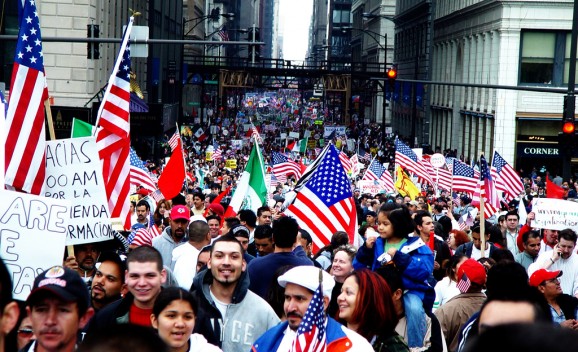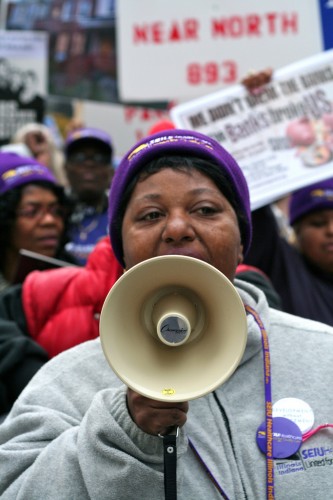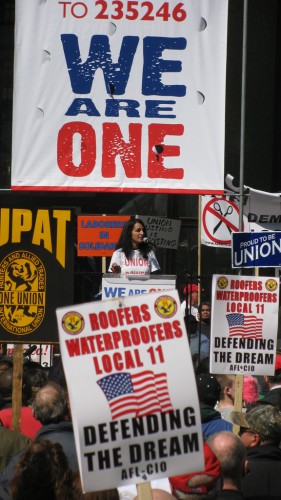The Birthplace of Community Organizing
Sources
Nancy Aardema, executive director, Logan Square Neighborhood Association. 312-384-4370. naardema@lsna.net
Jennifer Arwade, executive director, Albany Park Neighborhood Council. Works on housing, youth, and immigration issues in an incredibly multicultural neighborhood. 773-583-1387. jenny@apncorganizing.org
Matt Ginsberg-Jaeckle, Southside Together Organized for Power. STOP has organized tenants in subsidized buildings and worked with Occupy Chicago fighting the closing of city mental health centers; also sponsors Fearless Leading by the Youth. 773-355-8222. mateogj@gmail.com
George Goehl, National Peoples Action. 312-243-3035. george@npa-us.org. Mary Moreno is communications director. 202-421-0809. mary@npa-us.org
Tom Lenz, Lead Organizer, United Power for Action and Justice. 312-925-9505. tomlenz@uic.edu
Brian Malone, executive director, Kenwood Oakland Community Organization. 773-548-7500. jbkm1@yahoo.com
Rigo Padilla, Immigrant Youth Justice League. 773-614-9668. rigo.padilla@gmail.com
Amisha Patel, executive director, Grassroots Collaborative. The Grassroots Collaborative unites eleven membership-based organizations in Illinois in order to create policy change on local and statewide levels. 773-368-5366. amisha@thegrassrootscollaborative.org
Jose Oliva, policy director, Restaurant Opportunities Centers United. Oliva has a long history in the worker center movement. 773-612-2559. jose@rocunited.org
Elce Redmond, South Austin Coalition. 312-213-3989. elce@sbcglobal.net
Madeline Talbott, Action Now. Veteran organizer in low-income communities on the Wedst Side. 312-676-4280. mtalbott123.gmail.com
Ellen Schumer, executive director, Community Organizing and Family Issues. Organizes mothers and grandmothers in low-income communities. 312-226-5141. eschumer@cofionline.org
Kim Wasserman Nieto, executive director, Little Village Environmental Justice Organization. 773-762-6991. coordinator@lvejo.org

A 2006 rally for immigrant rights was Chicago's largest ever. The march, which drew between 250,000 and 500,000 people was a peaceful and effective demonstration of political power. (Image: jvoves CC-by-nc-sa)
By Curtis Black
Chicago is considered the birthplace of community organizing; this is where Saul Alinsky founded the Back of the Yards Neighborhood Council in 1939 and the Industrial Areas Foundation in 1940, and where Barack Obama was trained in that tradition forty years later.
Obama’s first presidential campaign employed community organizing strategies, and the Obama connection has brought negative attention to Alinsky (which many here would consider ill-informed and at times hysterical) from the president’s political rivals.
Those controversies aren’t very relevant in Chicago’s communities – but community organizing is, providing one of the main avenues for neighborhood residents to voice their concerns and demand a seat at the decision-making table on major issues facing affecting their lives.
The basic framework remains: bottom-up organizing to identify community concerns and develop grassroots leadership. An emphasis on neighborhood issues and victories is balanced with broader policy campaigns. Since Alinsky’s day, organizers have incorporated racial and gender justice analyses to their understanding of how power works.
Working in ad-hoc coalitions, community groups have won a series of reforms: a living wage ordinance for city contractors, affordable housing funding mechanisms, a Cook County Foreclosure Mediation Program and ordinances requiring banks to keep up buildings in foreclosure, among others.
“To the extent the City Council functions as a legislation body, it’s when community organizations have pressed aldermen on particular issues,” notes John McDermott of the Logan Square Neighborhood Association.

October 2009 - Union faithful march on the American Bankers Association conference to demand banks stop lobbying against financial reform. (Image: Kate Thomas / SEIU CC-by-nc-sa)
Community organizations have long attacked the imbalances in the power structure that today motivate the Occupy movement. “There is no road to a fair economy and true democracy that does not include going toe-to-toe with abusive corporations,” said George Goehl, executive director of National Peoples Action, a national network of community organizations founded and based in Chicago.
Occupy has raised the profile of that analysis, and Occupy Chicago and related neighborhood-based Occupy groups have worked with community organizations – particularly in occupations, including the Mental Health Movement’s recent occupation of a South Side clinic, one of six being closed by the city.
Foreclosures and Housing
Chicago has been hard hit by the foreclosure crisis; the metropolitan area had the second highest foreclosure rate in the nation last year. Community organizations have responded with a variety of strategies, from pressuring banks to modify mortgages to occupying foreclosed homes.
Meanwhile a tenacious community development movement has continued to develop affordable housing even in the depths of the recession, and tenant organizers are working to maintain federally-subsidized housing.
Schools
The struggle over two versions of “school reform” – top-down, based on mayoral control, or bottom-up, strengthening the city’s unique Local School Councils [PDF link] – has focused on the annual rite of school closings in low-income communities. Two groups in communities that have been hard-hit by closings — Kenwood Community Organization, in Bronzeville, and Blocks Together, in West Humboldt Park — have led a series of campaigns against closings and what they call disinvestment in neighborhood schools. KOCO members sat in at the mayor’s office in December.
Logan Square Neighborhood Association, celebrating its 50th anniversary in May, pioneered the development of full-service community schools, with after-school programming for kids, and educational programs (GED, ESL, citizenship classes) for parents and community members. The approach centers on promoting parent involvement; LSNA’s nationally-recognized parent mentor program, training and supporting classroom volunteers, is poised to go statewide; another program training parents and community members to become teachers already has.
Other community organizations have taken up this model, including Brighton Park Neighborhood Association, Enlace Chicago, and Southwest Organizing Project. BPNC has parent leadership teams, resource coordinators, and support for at-risk students in four schools. These strategies have helped low-income schools acheive academic growth levels that have eluded schools subject to central office intervention.
Last year community groups led by LSNA articulated their vision with an agenda for neighborhood schools. They’ve found strong support in the state legislature for an ongoing effort to require transparency from CPS on spending on facilities, long weighted against neighborhood schools. Recently, in response to the “rubber stamp” board of education appointed by the mayor since 1997, they’ve launched a drive to bring back an elected school board.
Youth
“Chicago has set the trend for youth-centered organizing,” said Sam Finkelstin of GenderJust, an LGBTQ youth group has pushed for more health resources for queer youth on the South and West Sides and more support in high schools.
Southwest Youth Collaborative has been organizing youth at its drop-in centers for 20 years, with a focus improving the juvenile justice system and addressing the criminalization of youth in public schools.
Community organizations like Albany Park Neighborhood Council, Blocks Together, Organization of the North East, BPNC, and KOCO have youth councils and integrate youth into the organization’s overall decision-making framework. Over more than a decade they’ve seen youth activists develop into professional organizers and community leaders, said Raul Botello, education organizer for APNC.
Blocks Together, APNC, and a coalition of community organizations called Voices of Youth in Chicago Education have focused on public schools’ zero-tolerance discipline policies, which they say target minority youth and create a “school-to-prison pipeline.” Also pressing that issue is the High Hopes Campaign, spearheaded by church leaders in the Community Renewal Society, a civil rights organization. POWER – PAC, a parents group organized by Community Organizing and Family Issues, has piloted restorative justice in West Side elementary schools.
Mikva Challenge has implemented peace circles as alternatives to zero-tolerance in high schools with success, perhaps most impressively at Fenger High School, notorious for the 2009 killing of Derrion Albert. It’s one of a wide range of civic education projects offered by the group.
The Chicago Freedom School offers a summer program that gives high school students a background in social change movements and organizing strategies. Students undertake individual issue campaigns in the following year.
In Little Village, Enlace Chicago‘s annual youth forum on gangs and violence drew 1,000 last year, and Little Village Environmental Justice Organization has a youth group that engages kids in environmental and youth issues, as well as artistic endeavors.
In Woodlawn, Fearless Leading by the Youth has a dogged effort underway to pressure the University of Chicago Medical Center to reopen its trauma center, since a founding member died after being shot near UCMC and transported to a hospital across town.
Undocumented youth have “come out of the shadows” in speak-outs organized by the Immigrant Youth Justice League – and have taken on greater risks with civil disobedience pressuring politicians to act on the DREAM Act, which would provide a path to citizenship to immigrants brought here as children.

Six activists with the Little Village Environmental Justice Organization (LVEJO), Rising Tide North America, Rainforest Action Network (RAN) and the Backbone Campaign climbed the fence to Midwest Generation’s controversial Crawford coal plant in Little Village. (Image: RAN CC-by-nc)
Environmental Justice
Based in Altgeld Gardens, the Far South Side public housing development, People for Community Recovery was a pioneer of the environmental justice movement, fighting the environmental hazards clustered around low-income minority communities. The group continues to work for cleanup of the area, often in collaboration with grassroots groups in the new Environmental Justice Alliance of Greater Southeast Chicago.
Formerly dominated by heavy industry, the area includes the largest wetlands in the region. Groups recently beat back a city attempt to site a police firing range amidst sensitive wetlands; they’re currently opposing a proposed coal-to-gas plant and other threats.
Little Village Environmental Justice Organization and the Pilsen Environmental Rights and Reform Organization and allies recently won a long-term campaign – with tactics ranging from lawsuits to civil disobedience — to shut down two old coal plants; now they’re mobilizing to make ensure community input in decisions about development of the sites. They want local employment along with green space and public access to the Chicago River.
Worker centers
Combining community and labor organization, workers centers use a variety of strategies to organize low-wage and immigrant workers often overlooked by the labor movement. A recurring issue is wage theft.
In the massive industrial park area outside O’Hare Airport, the Chicago Workers Collaborative organizes among hundreds of thousands of “permatemps” in factories that using staffing agencies for hiring. The Latino Union organizes day laborers hired on street corners. Arise Chicago mobilizes the religious community to back up low-wage immigrant workers in small shops, from factories to car washes.

Amisha Patel of the Grassroots Collaborative. (Image: Teresa Albano / peoplesworld CC-by-nc)
Two efforts focus on specific industries: Warehouse Workers for Justice organizes workers in the huge warehouse district around Joliet, and has helped them sue for wage theft in Wal-Mart warehouses. The Restaurant Opportunities Center focuses on a growing low-wage sector, protesting wage theft and encouraging “high-road” management which offers good wages and benefits.
Coalitions
Jobs With Justice is the oldest labor-community coalition, now focused on serving and organizing – and raising the visibility of — the long-term unemployed. Stand Up Chicago is newer coalition, concentrated on corporate tax evasion.
Grassroots Collaborative is the labor-community coalition with the greatest focus on local policy. It won a living wage ordinance 12 years ago, fought Wal-Mart’s entry to the city (their big box living wage ordinance forced Mayor Richard Daley to issue his only veto in two decades in office), and now pushes for equity in the city budget and defense of public services.
National Peoples Action grew out of West Side anti-redlining organizing in the 1970s and represented a new step for community groups: a national network uniting community groups around a common policy agenda. The group is particularlly focused on accountability for the banks that busted the economy.
That includes the regulators and legislators who deal with them – who are likely to get surprise visits during NPA’s national mobilization, May 19-21 in Washington DC. One likely target is Federal Home Finance Authority director Edward DeMarco, who is blocking principal reductions for troubled homeowners with government-backed mortgages.
A newer regional network is IIRON, which includes Northside POWER and Southsiders Organized for Unity and Liberation and focuses on corporate accountability.
Legacy
Saul Alinksy founded the Back of the Yards Neighborhood Council and, to provide training to community organizations, the Industrial Areas Foundation. BYNC, now a major institution serving a new immigrant community, turned from organizing to economic development a couple decades ago, and provides a range of family services. Chicago-based IAF has three affiliates in the area: United Action for Justice and Power, which joins Cook County congregations and community groups — one focus is on health care reform — and Lake County United and DuPage United in the suburbs.
Developing Communities Project, incorporated under the leadership of Barack Obama in 1986, has been deluged by inquiries from journalists in recent years and has become necessarily selective about responding, executive director Gwen Rice says.
DCP has pushed for years for an extension of the CTA’s Red Line to 130th Street, reaching a low-income community that’s the last area in the city unserved by rapid transit. There has been slow progress. “Every step has been challenging,” said Rice. With talk of public-private financing for the project, they want to weigh the benefits make sure the community is at the table when decisions are made. One priority is ensuring that work on the extension goes to local residents.
DCP is also leading community efforts around environmental concerns, and the group continues its work on youth development and violence prevention, all from a social justice perspective.
One recent loss is Hull House, the social service agency founded as a settlement house by Nobel Peace Prize winner Jane Addams in 1889. In its early days Hull House was dedicated to empowering low-income immigrant residents of the Near West Side. It evolved into an agency providing child care, job training, housing assistance and other services for 60,000 people a year. But with demand for services up and funding sources scarce, Hull House closed in January.